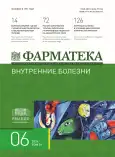Клинико-эпидемиологическая характеристика сепсиса у детей, госпитализированных в стационар 3-го уровня
- Авторы: Вахитов Х.М.1, Зиятдинова Л.М.2, Сафиуллина Н.Д.1, Исмагилова М.И.2, Миргалимов Д.Р.2
-
Учреждения:
- Казанский государственный медицинский университет
- Детская республиканская клиническая больница
- Выпуск: Том 31, № 6 (2024)
- Страницы: 18-23
- Раздел: Педиатрия
- URL: https://journal-vniispk.ru/2073-4034/article/view/273308
- DOI: https://doi.org/10.18565/pharmateca.2024.6.18-23
- ID: 273308
Цитировать
Аннотация
Актуальность. Согласно литературным данным, ежегодно в мире от сепсиса умирают более 3 миллионов детей, а общее число выставленных диагнозов «сепсис» в детской популяции превышает 25 миллионов. Сепсис в детском возрасте имеет значительные отличия от взрослых пациентов по клиническим симптомам, характеру течения, тяжести состояния и тактике ведения.
Цель исследования: изучить эпидемиологию и этиологию септических состояний у детей различного возраста в условиях стационара.
Методы. Проведено ретроспективное исследование по изучению факторов риска, этиологии и маршрутизации 28 детей различных возрастных групп с установленным диагнозом «сепсис», проходивших лечение в детском стационаре 3-го уровня.
Результаты. Показано, что среди групп возбудителей доминирующее положение сохранятся за грамотрицательной флорой, а ведущее место среди отдельных микроорганизмов принадлежит Staphylococcus aureus. С учетом того, что золотистый стафилококк также оказался доминирующим возбудителем и у детей с респираторными инфекциями, госпитализированных в изоляционно-диагностическое отделение, авторы предполагают его влияние не только на распространенность, но и на тяжесть течения инфекционного процесса. В 23% случаев диагноз сепсис выставлялся на основании высева одного возбудителя из 2 и более локусов. Продемонстрировано также, что дети младших возрастных групп более склонны к развитию генерализованных форм инфекционного процесса: все 28 детей были младше 12 лет.
Выводы. Дальнейшее изучение различных клинико-эпидемиологических аспектов развития септических состояний позволит раскрыть актуальные механизмы инфицирования, а также варианты ответных реакций организма на генерализованную инфекцию, что послужит основой для персонифицированного подхода к лечению сепсиса у детей.
Ключевые слова
Полный текст
Открыть статью на сайте журналаОб авторах
Х. М. Вахитов
Казанский государственный медицинский университет
Email: vhakim@mail.ru
ORCID iD: 0000-0001-9339-2354
д.м.н., профессор
Россия, КазаньЛ. М. Зиятдинова
Детская республиканская клиническая больница
Автор, ответственный за переписку.
Email: vhakim@mail.ru
ORCID iD: 0009-0009-5592-2110
Россия, Казань
Н. Д. Сафиуллина
Казанский государственный медицинский университет
Email: vhakim@mail.ru
ORCID iD: 0009-0009-1937-1681
Россия, Казань
М. И. Исмагилова
Детская республиканская клиническая больница
Email: vhakim@mail.ru
ORCID iD: 0000-0002-6074-4541
Россия, Казань
Д. Р. Миргалимов
Детская республиканская клиническая больница
Email: vhakim@mail.ru
ORCID iD: 0009-0006-4942-1844
Россия, Казань
Список литературы
- Лекманов А.У., Миронов П.И. Сепсис в педиатрической практике – пора договариваться. Российский вестник перинатологии и педиатрии. 2020;65(3):131–37. [Lekmanov A.U., Mironov P.I. Sepsis in pediatric practice - time to negotiate. Russian Bulletin of Perinatology and Pediatrics. 2020;65(3):131–37. (In Russ.)]. doi: 10.21508/1027-4065-2020-65-3-131-137.
- Rudd K.E., Johnson S.C., Agesa K.M. et al. Global, regional, and national sepsis incidence and mortality, 1990-2017: analysis for the Global Burden of Disease Study. Lancet. 2020;395(10219):200–11. doi: 10.1016/S0140-6736(19)32989-7.
- Weiss S.L., Fitzgerald J.C., Pappachan J., et al. Sepsis Prevalence, Outcomes, and Therapies (SPROUT) Study Investigators and Pediatric Acute Lung Injury and Sepsis Investigators (PALISI) Network. Global epidemiology of pediatric severe sepsis: the sepsis prevalence, outcomes, and therapies study. Am J Respir Crit Care Med. 2015;191(10):1147–15. doi: 10.1164/rccm.201412-2323OC.
- Boeddha N., Schlapbach N., Driessen G., et al. Mortality and morbidity in community-acquired sepsis in European pediatric intensive care units: a prospective cohort study from the European Childhood Life-threatening Infectious Disease Study (EUCLIDS). Crit Care. 2018;22:143. doi: 10.1186/s13054-018- 2052-7.
- Weiss S.L., Peters M.J., Alhazzani W., et al. Surviving sepsis campaign international guidelines for the management of septic shock and sepsis-associated organ dysfunction in children. Intensive Care Med. 2020;46(1):10–67. doi: 10.1007/s00134-019-05878-6.
- Killien E.Y., Farris R.W.D., Watson R.S., et al. HealthRelated Quality of Life Among Survivors of Pediatric Sepsis. Pediatr Crit Care Med. 2019;20(6):501–9. doi: 10.1097/PCC.0000000000001886.
- Schlapbach L.J., Straney L., Alexander J., et al; ANZICS Paediatric Study Group. Mortality related to invasive infections, sepsis, and septic shock in critically ill children in Australia and New Zealand, 2002-13: a multicentre retrospective cohort study. Lancet Infect Dis. 2015;15(1):46–54. doi: 10.1016/S1473-3099(14)71003-5.
- Watson R.S., Carcillo J.A., Linde-Zwirble W.T., et al. The epidemiology of severe sepsis in children in the United States. Am J Respir Crit Care Med. 2003;167(5):695–701. doi: 10.1164/rccm.200207-682OC.
- De Souza D.C., Goncalves Martin J., Soares Lanziotti V., et al. SPREAD PED Investigators and the Instituto Latino Americano de Sepsis Network. The epidemiology of sepsis in paediatric intensive care units in Brazil (the Sepsis PREvalence Assessment Database in Pediatric population, SPREAD PED): an observational study. Lancet Child Adolesc Health. 2021;5(12): 873–81. doi: 10.1016/S2352-4642(21) 00286-8.
- Klingenberg C., Kornelisse R.F., Buonocore G., et al. Culture-negative early-onset neonatal sepsis - at the crossroad between efficient sepsis care and antimicrobial stewardship. Front Pediatr. 2018;6:285. doi: 10.3389/ fped.2018.00285.
- Schlapbach LJ, Watson RS, Sorce LR, et al. Society of Critical Care Medicine Pediatric Sepsis Definition Task Force. International Consensus Criteria for Pediatric Sepsis and Septic Shock. JAMA. 2024;331(8):665–74. doi: 10.1001/jama.2024.0179.
- Хаертынов Х.С. Неонатальный сепсис: микробные и иммунные факторы в диагностике и прогнозе заболевания: специальность. Автореф. дисс. докт. мед. наук. Казанский государственный медицинский университет. Электрон. текстовые дан. (372 КБ). Казань, 2019. 39 с. [Khaertynov H.S. Neonatal sepsis: microbial and immune factors in diagnosis and prognosis of the disease: specialty. Abstract of Diss. for Doct. of Med. Sciences. Kazan State Medical University. Electronic text data. (372 KB). Kazan, 2019. 39 p. (In Russ.)].
- Kumar A., Roberts D., Wood K.E., et al. Duration of hypotension before initiation of effective antimicrobial therapy is the critical determinant of survival in human septic shock. Crit Care Med. 2006;34(6):1589–96. doi: 10.1097/01.CCM.0000217961.75225.E9.
- Legrand M., De Backer D., Depret F., Ait-Oufella H. Recruiting the microcirculation in septic shock. Ann Intensive Care. 2019;9:102. doi: 10.1186/s13613-019-0577-9.
Дополнительные файлы








